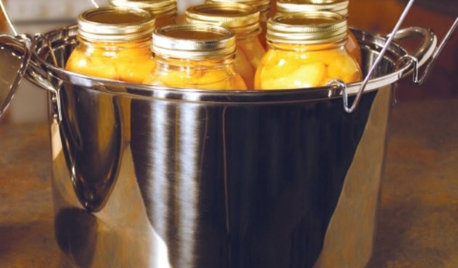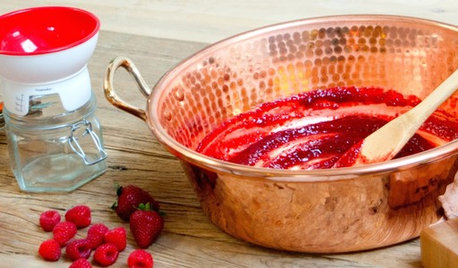How can I adjust this freezer jam recipe to water bath canning?
Charcuterie
12 years ago
Related Stories

KITCHEN DESIGNKitchen Recipes: Secret Ingredients of 5 One-of-a-Kind Cooking Spaces
Learn what went into these cooks’ kitchens — and what comes out of them
Full Story
PRODUCT PICKSGuest Picks: Canning, Preserving, Steaming, Dehydrating
20 products to help make fall produce last through the season and beyond
Full Story
SMALL HOMESCan You Live a Full Life in 220 Square Feet?
Adjusting mind-sets along with furniture may be the key to happiness for tiny-home dwellers
Full Story
KITCHEN DESIGNTrending Now: 25 Kitchen Photos Houzzers Can’t Get Enough Of
Use the kitchens that have been added to the most ideabooks in the last few months to inspire your dream project
Full Story
SHOP HOUZZHouzz Products: Save a Taste of Summer
Can't bear to part with the flavors of summer peaches, berries and tomatoes? Then jam on it!
Full Story
GREEN DECORATINGEasy Green: Big and Small Ways to Be More Water-Wise at Home
These 20 tips can help us all make the best use of a precious resource. How do you save water in summer?
Full Story
MUDROOMSThe Cure for Houzz Envy: Mudroom Touches Anyone Can Do
Make a utilitarian mudroom snazzier and better organized with these cheap and easy ideas
Full Story
LAUNDRY ROOMSThe Cure for Houzz Envy: Laundry Room Touches Anyone Can Do
Make fluffing and folding more enjoyable by borrowing these ideas from beautifully designed laundry rooms
Full Story
SAVING WATER11 Ways to Save Water at Home
Whether you live in a drought-stricken area or just want to help preserve a precious resource, here are things you can do to use less water
Full Story
FEEL-GOOD HOME12 Very Useful Things I've Learned From Designers
These simple ideas can make life at home more efficient and enjoyable
Full Story






pixie_lou
CharcuterieOriginal Author
Related Professionals
Foothill Ranch Landscape Architects & Landscape Designers · Mount Wilson Landscape Architects & Landscape Designers · Edmond Landscape Contractors · Fort Wayne Landscape Contractors · Haverhill Landscape Contractors · Kerman Landscape Contractors · Lemay Landscape Contractors · Lyndhurst Landscape Contractors · Milford Mill Landscape Contractors · Selden Landscape Contractors · South Lake Tahoe Landscape Contractors · Tyngsboro Landscape Contractors · Crowley Landscape Contractors · Columbus Roofing & Gutters · Lancaster Roofing & Guttersreadinglady
CharcuterieOriginal Author
2ajsmama
pixie_lou
2ajsmama
readinglady
2ajsmama
Karly30
readinglady
2ajsmama
nightstlkr
2ajsmama
readinglady